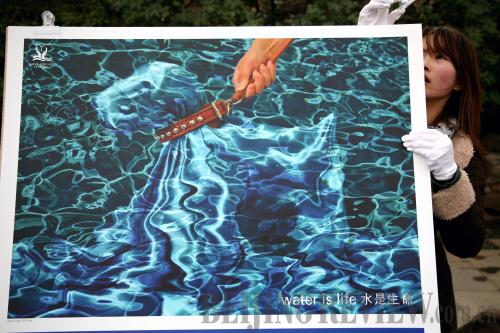|
 |
|
CALLING ATTENTION: A woman displays a safe water awareness poster at a themed exhibition in Nanjing, Jiangsu Province, on World Water Day on March 22. This year, the event focused on urban water challenges (WANG XIN) |
Houses lining up meandering rivers make Jiaxing in east China's Zhejiang Province a famed water city. Yet the Venetian-style center is suffering from a water shortage.
Jiaxing has a population of more than 3 million. Its per-capita water availability is about 800 cubic meters, about one 10th of the world average, says the city government.
Its water shortages are exacerbated by pollution. Most of the city's surface water is at or below the Grade V standard.
According to China's Environmental Quality Standards for Surface Water, water rated between Grades I and III can be used as drinking water sources.
Water of Grade IV quality is safe for general industrial use and recreational water bodies with no direct skin contact. Grade V is safe for agricultural use and general landscape, whereas water rated below Grade V is unsafe for any use.
Guangdong in south China has a humid weather. Its average annual precipitation is 1,774 mm, 2.74 times that of the national average. But, it too is suffering from severe shortages, according to the province's Department of Water Resources.
Water in the Pearl River, China's second largest river in terms of runoff volume, and in other rivers is below the Grade V standard, the department said.
A Bulletin of China's Environmental Conditions in 2009 released by the Ministry of Environmental Protection shows the quality of water in nine of the country's largest fresh water lakes monitored between Grade III to Grade V or below.
It also says among the 408 sections of the 203 rivers monitored, 57.3 percent has water quality between Grade I and III, 24.3 percent, between Grade IV and V, and 18.4 percent, below Grade V.
Water quality in the Pearl and Yangtze rivers is generally good, the Songhua River in the northeast and the Huaihe River in the east are lightly polluted, whereas the Yellow River and the Liaohe River in the northeast are moderately polluted. The Haihe River in the north is seriously polluted, the report says.
Due to environmental pollution, one fourth of China's population does not have access to clean drinking water, says a recent report from the National Development and Reform Commission.
Drinking water sources are gravely polluted, but most water treatment plants in China are still using the same drinking water treatment process that have been around for more than a century, said the Beijing-based The Economic Observer.
Community water systems in China commonly use flocculation, sedimentation, filtration and disinfection processes to treat surface water, experts say.
"These century-old technologies are not suitable to handle today's water quality," said Liu Wenjun, Director of the Division of Drinking Water Safety of the Department of Environmental Science and Engineering, Tsinghua University.
Wang Zhansheng, a professor at the School of Environmental Studies at Tsinghua University, blamed the antiquated water supply management system on the lack of implementation of the national drinking water standards.
"The previous standards, which were issued in 1985, mainly targeted microbes such as coliform bacteria and were aimed at preventing water-born infectious diseases. They did not address harmful organic and chemical contaminants, such as heavy metals and pesticides," Wang said.
In 2006, the new drinking water quality standards were promulgated. They have been partly enforced since 2007 and are to be completely enforced by 2012. The five-year phase-in period is for water supplying plants to improve their technology.
The new standards require 71 more quality indicators to be monitored on top of the previous 35.
But, most Chinese cities, except for megacities such as Beijing, are not able to test the 106 indicators, Wang said.
Aside from technology, cost considerations on the part of water suppliers may hamper the use of some effective treatment processes.
"Ozone activated carbon process, for instance, can absorb some contaminants and improve water quality, and this process will add 300 yuan ($45) per ton of water treated," Wang said. But, he believes the public should be willing to accept such a price increase in return for better water quality.
Cities have adopted various measures to address water pollution. Jiaxing invested a large amount of money to treat waste water. In 2009, it treated 83.53 percent of municipal waste water and 100 percent of industrial waste water.
Shanghai has taken numerous measures to clean up the Huangpu River, which supplies drinking water to 80 percent of its residents but was heavily polluted last century. It increased investment in waste water treatment facilities, closed down highly polluting plants and poultry farms along the river, and diverted water from the Yangtze River. A new regulation on protecting drinking water sources went into effect on March 1.
Guangdong is adjusting its industrial structure to limit the growth of water-consuming industries and transferring water from other water bodies into cities. In the next five years, it plans to launch more water-transfer projects.
Before last November, Guangzhou, capital of Guangdong, took measures to improve water quality, including transferring water from other water bodies and improving water treatment processing. As a result, tap water quality in Guangzhou had already met the new drinking water quality standards, said the Guangzhou Water Supply Co. | 